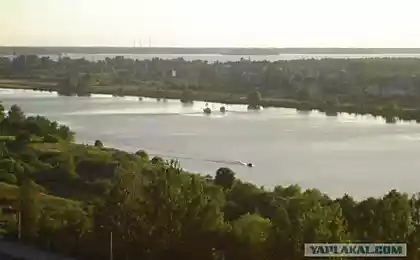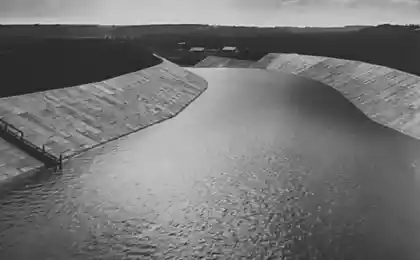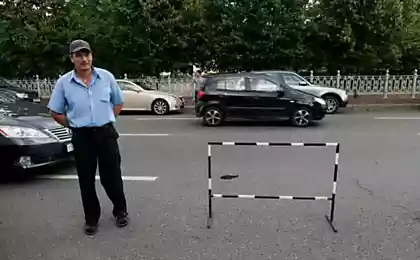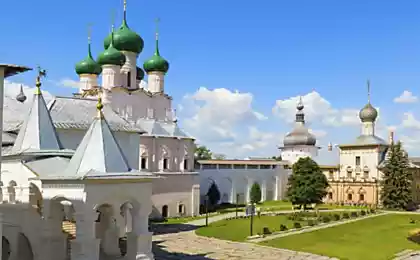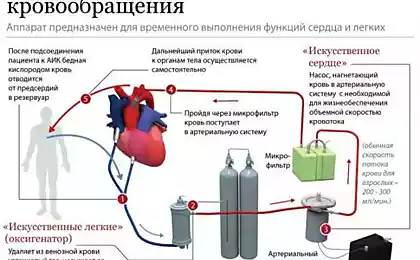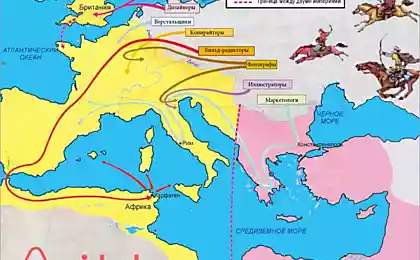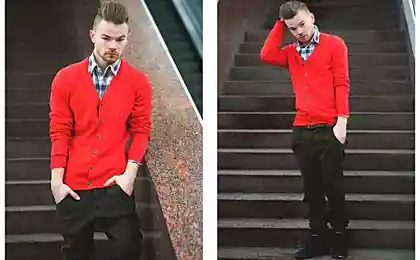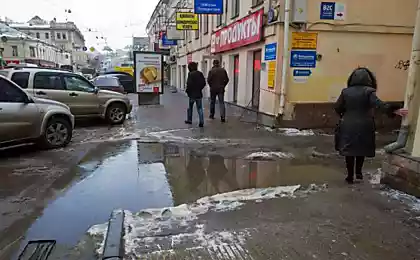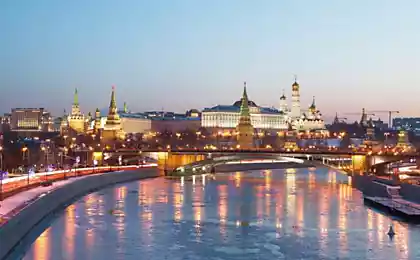2222
Two Moscow
Works from the project "Two of Moscow" from an artist from Moscow Konstantin Konovalovoa. The essence of the project - the combination of photos this time with historical photos of the same places. Each photograph is accompanied by a small, he notes, tells the history of the photographed places.
To immerse yourself in a different era, you need to find exactly the position for the picture that the photographer chose a few decades ago. All pictures are taken on the iPad and combined with old it is, right on the shooting location. That, in the opinion of the author, allows you to forget about the special image processing on the computer and brings regular users of the same cognitive Instagram to like entertainment.
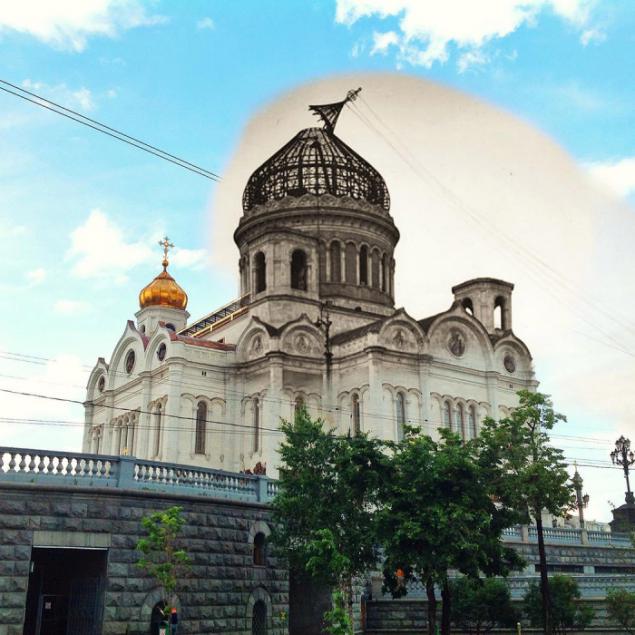
Back in 1931. Demolition of the Cathedral of Christ the Savior / Our days.

KGB building - perhaps the worst building in Moscow (where a lot of people were shot, and there was almost a century sit power structures of our country).
First building was built in the neoclassical style to the insurance company "Russia", but it gave the NKVD in 1919. Then, when it was necessary to increase the inner prison for political prisoners, the building expanded, attach to it a new building in the style of constructivism. The building became asymmetric and stood there for almost half a century. And then the original facade built up, making a symmetrical building in the 80s. If you open the map Google, you'll see that the top of the building is not symmetrical, and is located in a place where to be Malaya Lubyanka.
Standing in front of the monument to Dzerzhinsky. Now it is not, but the place is in the center of the Lubyanka Square to the monument remains and looks weird. And no one knows how you can put a monument there, because the poet put in front of "bloody" building unethical. A Soviet leaders monuments no longer set, but rumors of a monument to Gagarin.
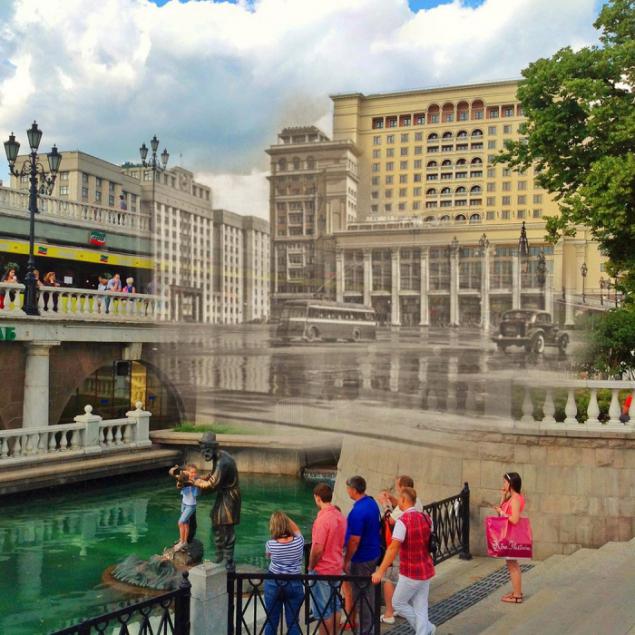
Manezh Square and Ryad.
Ryad is so called because in the past there has sales ranks of suburban hunters who sell meat and poultry. Of all the things in frames, save only the building of the State Duma, "Moscow" hotel was rebuilt recently. On the site of the modern underground shopping center used to be a driveway. The photo shows one of the first Soviet trolleybuses YATB-1.
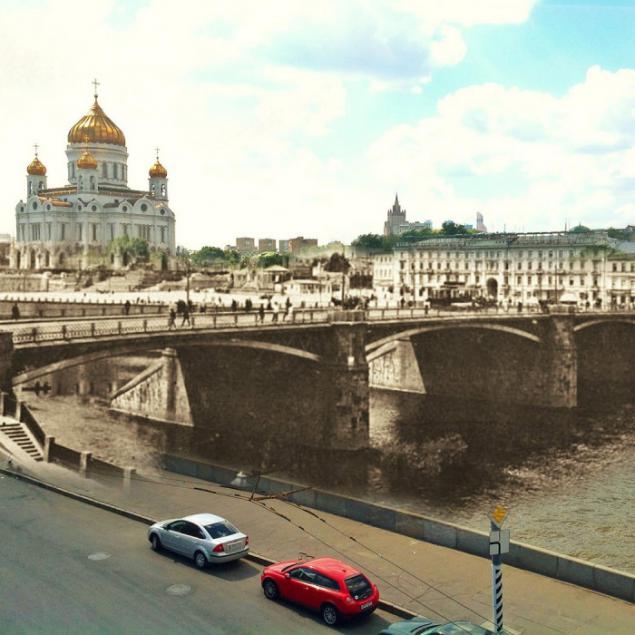
Big Stone Bridge.
This bridge was rebuilt twice, and now it is just downstream of the Moscow River than originally. First was built really beautiful stone bridge, which consisted of a set of arcs (in 1687). Photos of the time no, because the photo has not yet been invented, but it Vasnetsov painted the picture "All Saints stone bridge." Then the bridge was rebuilt in the one depicted in these photos - metallic, three-span (1858). And in 1938 built the existing stone bridge. Previously bridge connects the street Lenivka and was closer to the Christ the Savior Cathedral.
I am insanely inspired architecture of this bridge. Moscow lacks such beautiful designs. Modern bridges do not fit into the ensemble of the Kremlin and the historical part of the city.

Sukharev Tower (view from Sretenki).
At first I could not pick the correct position for the photos because guided by the bell tower of the temple of the Trinity in sheets, but, as it turned out, this bell tower several times changed shape. And today - is recreated from photographs. She has all the proportions are met, but the size of it came a little more than it was before, and slightly offset relative to the initial placement. And now the main!
Sukharev Tower. She told Peter to build in 1692-m, and ordered to demolish Stalin in 1934. Decided to demolish it for a reason and now a popular problem - growing traffic transport. She stood at the intersection of the Garden Ring and Sretenka street. The photograph is wonderful 1931.
Great painters and architects have sent a letter to Stalin:
"Sukharev Tower has a sample of the great perennial building art, known worldwide and everywhere equally highly valued. Despite all of the latest advances in technology, it still has not lost its huge demonstration and educational value for construction personnel. " "We ... strongly object to the destruction of highly talented works of art, is tantamount to the destruction of the paintings of Raphael. In this case, the matter is not about Slomka odious monument to the era of feudalism, and the death of the great masters of creative thought ».
But they have not convinced Stalin ... I wonder how would look Sretenka Garden Ring and now, under the current traffic if the tower preserved?
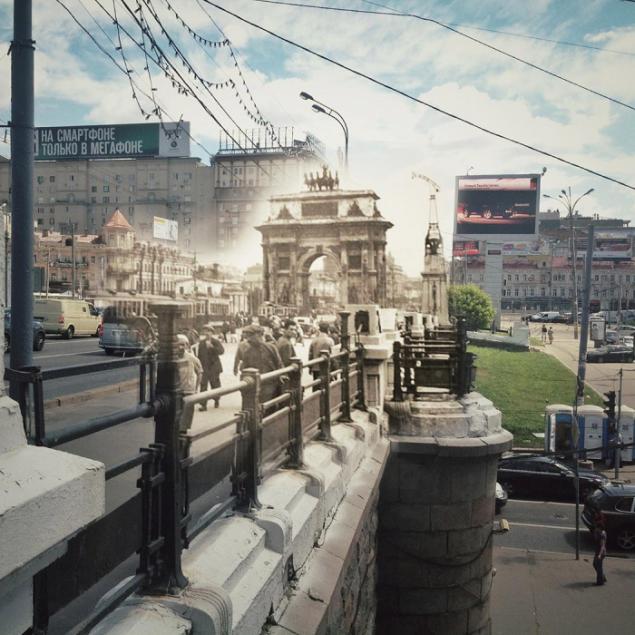
Arc de Triomphe.
Arc de Triomphe - is a cult! Country someone won or achieved something - build an arch through which pass triumphant victors. These arches are all over the world: at the Place Charles de Gaulle in Paris, the Brandenburg Gate in Berlin or Moscow on Kutuzov. But here in Moscow arch originally was not on Kutuzov, and on Tverskaya Zastava Square in Belosrusskaya.
In 1936, as well as the Sukharev Tower, Arch was demolished in the reconstruction of the area, although it promised to restore to the same place, but not restored. More precisely restored, but where it is now established, and 30 years later. We like to break, and then build again! Arch dedicated to the victory over Napoleon.
Separately want to say that I am very surprised that the railing of the bridge over the railway Belarusian direction from which I took a picture, remained unchanged.
And an amazing feeling when you find yourself in exactly the point from which people almost a century ago, made a picture on your camera, and you're standing here with the iPad and take pictures of the same pan, but in the center of the frame is no longer of grandeur for which the person has come here with the camera. It's hard to describe it, but try it for yourself!
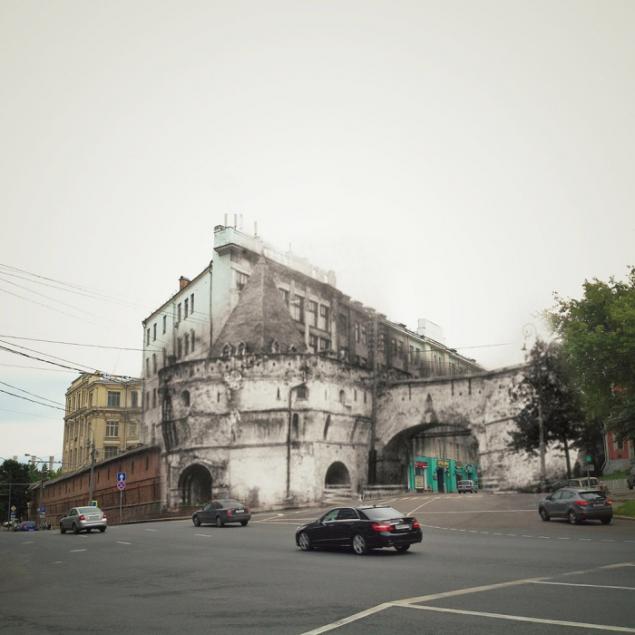
Tower Barbarian gate.
Now people wonder why in Moscow so many places named in honor of some gates: Nikita, Prechistenskaya, Pokrovsky, Barbaric gate. The thing is that before Moscow was surrounded by several defensive walls that were erected to protect from attacks of the Tatars, across the contour of the walls had towers with multiple gates.
Barbarian gate tower was considered the most robust in the Kitai-Gorod wall and had a deep foundation against undermining. Work on its construction began in 1534 and lasted until 1934, she when to get rid of. But now, after the underpass under the square Barbaric gate, on one wall of the transition, you will see the remains of the foundations of the tower - is all that is left of it.

Ilinskoe gate.
Continue a virtual tour of the Kitai-Gorod wall. By the way, in the late 16th century it was painted in white, and it was originally a brick. The photograph Ilyinskikh tower gate. The tower looks like the Kremlin, so it was rebuilt after a fire in 1812. This kind of Maroseika on Ilyinke. On the right hand is the building of the Museum, on the left Il'inskii Square with the monument to heroes of Plevna. Ilinskoe gates were located between Nikolskie and barbaric gate. Ilinskoe gate originally built in 1534, along with the Kitai-Gorod wall. Destroyed it all in 1933.
After the demolition of the gate named after them Ilinskoe gate area. Also wanted to call and a subway station, but the station decided not to build. Have you noticed that between the Revolution Square and Kursk too far? That's just on this site should be Ilinskoe station gates.
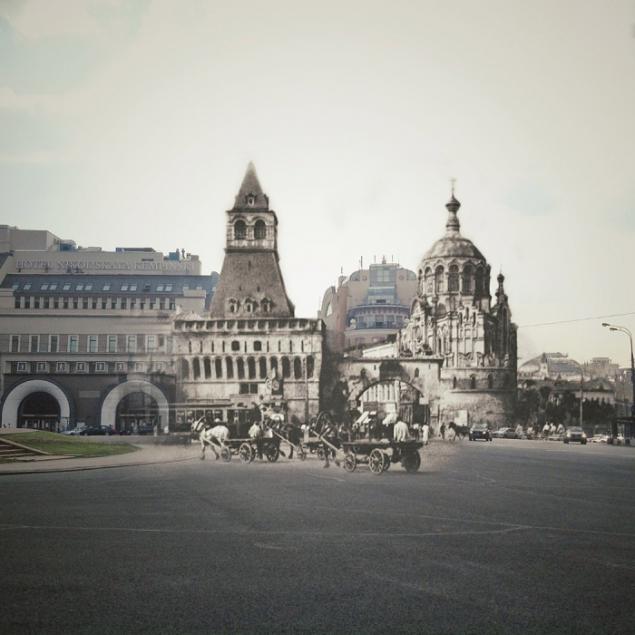
Vladimirskie gate.
Travel Kitaygorodskaya wall continues. Where now is Lubyanka Square, before the gates were Vladimirskie (they Sretensky or Nikolsky). Make this picture was harder earlier - there are no landmarks, cling to determine where is the tower and the gate and where the pictures were taken preserved. First, at this point in the time of Stalin tore down the wall, the temples of the walls, towers and gates, and built the first phase of the metro station - Dzerzhinsky (now Lubyanka) in 1934. And then when Luzhkov in 1998 built the shopping center "Nautilus", which is quite out of place in this part of town. Because of this huge shopping center is not visible houses on St. Nicholas.
I studied long-lasting prints and found a picture, which shows the tip of the Tretyakov Gate and glass dome of the hotel "Metropol". With these two reference points and their intersection at the pictures I already had a line, which was a picture was taken, but still lacked some clues. She was the tip of the apartment building on St. Nicholas, 21, and the angle of inclination of the Nicholas Street. Of course, there is some uncertainty, but more accurately recreate unlikely to succeed. I sketched on a map, determine the point of shooting, and went to shoot. The result is that the gate is in what is now the roadway (turn directions to the Theatre of New Square). At the place where now the Lubyanka station lobby, used to be a temple of the Vladimir Mother of God, and on-site shopping center "Nautilus" was a beautiful chapel of St. Panteleimon the Healer (pictured). Overall Lubyanka Square earlier was not as big as it is now.
Tower, as well as in Ilyinskikh gate, similar to the Kremlin as it was rebuilt in this style after a fire in 1812. Vladimirskie gates were second-hand city center. Most bookshops are found here. They settled in St. Nicholas deadlock. He was named so because it rested in Kitai-Gorod wall, but then in the wall made a small gate so that people could travel with the theatrical run to the bookstore. Almost all the houses here were destroyed in 1934. So Nicholas deadlock now is an imaginary place.
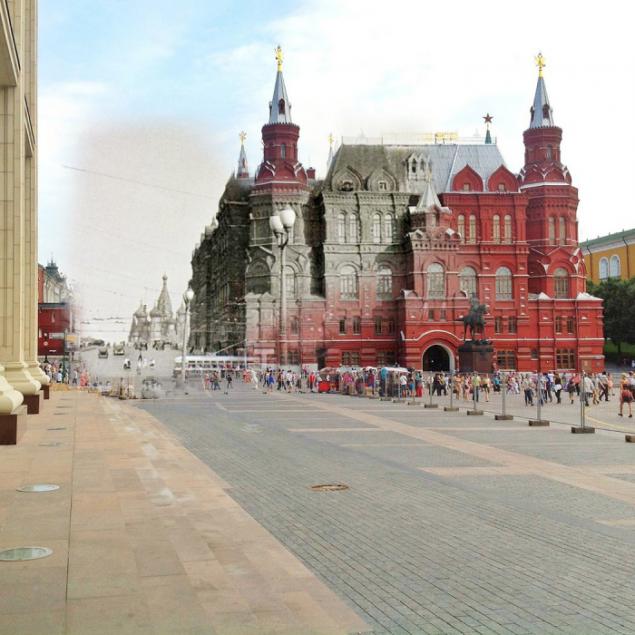
Resurrection (Iberian) gates and zero kilometer.
Built - broke - again built, if it is brief. Usually nobody thinks, but Resurrection Gates are Kitaygorodskaya wall. They are among the Historical Museum and the City Duma building and are the entrance to Red Square.
Gate built in 1680, destroyed in 1931 by order of Stalin, because road transport had to go to the Red Square, and military equipment are not held in such a narrow gate. For a long time there was a roadway, which is named after the Historical Museum - Historical travel, just to photograph it. Restore them in 1994. Luzhkov! And then did the pedestrian zone.
Before the gate is zero kilometer. It was established not long ago - in 1995. Here tourists throw coins over your left shoulder. But in fact it is not a zero kilometer. This is located at kilometer zero of the Central Telegraph building. Just in the Soviet time it wanted to establish before the mausoleum, but did not, and the bronze sign made and installed it in the nineties have recovered Resurrection Gate just. In Paris, for example, zero kilometer is at Notre-Dame de Paris.

House under the skirt.
This unusual name for this house, built in 1940, has appeared in the nation. The thing is that on the roof of the house at the intersection of Tverskaya Street (formerly Gorky) and the Boulevard was a sculpture of a ballerina. Until our days the sculpture is not preserved. There are several legends, why it was dismantled:
she began to break down and can not withstand wind flows, it was dismantled in order to not fall on passersby;
in time of war it wanted to remove in order to hide the prominent landmarks and enemy aircraft that was difficult to navigate the city, although the war she went through and stood up to the year 1958-1963 (the exact date of dismantling was not found);
Minister of Culture EA Furtsevoy not like the fact that she was in too short skirt and located on a hill.
There is a legend that the ballerina Lepeshinskii, the image of which was made sculpture, broke her arm and hand sculpture immediately fell off. After that, and made a complete dismantling, fearing the fall of other parts of the body at passersby.
Large pictures of this sculpture is not found, although it stood almost 20 years and was very noticeable. I think the sculpture of a ballerina on the roof is much better than the glowing logos, filling the entire roof of Moscow.
By the way, the site of this house until 1933 stood Demetrios Church.
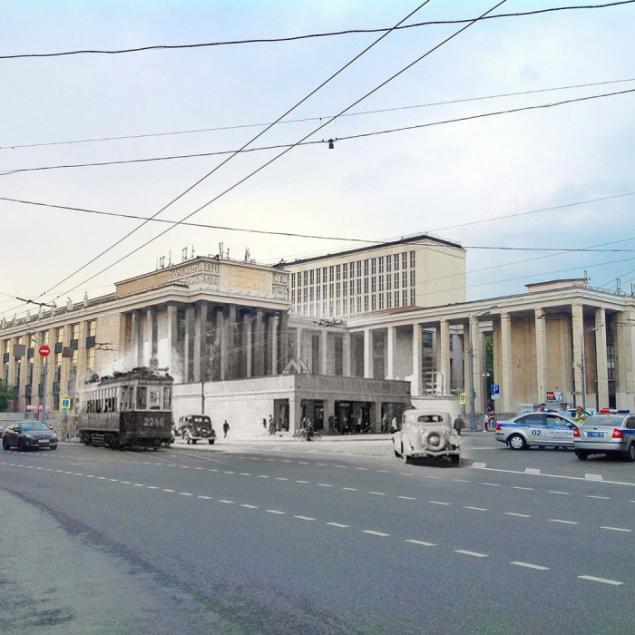
Metro station Comintern Street
Before the Russian State Library (Lenin Library) was the Comintern Street station lobby. Now the station is called "Alexander Garden" and that it has no lobby. There are only a general lobby station Arbat, located right in the building of the Russian library. Separate lobby was dismantled in the 40s. Now this place is an underground passage from which you can go on the subway, and a monument to Dostoevsky, established in 1997.
Comintern Street subway station was part of the first Moscow metro. Through its lobby could go down to the station and the Lenin Library, but the transplant between two stations was not originally.
The station also was called "Kalinin" (1946 and 1990). A few days in 1990, it was called "Vozdvizhenka" and this name even managed to put on metro.
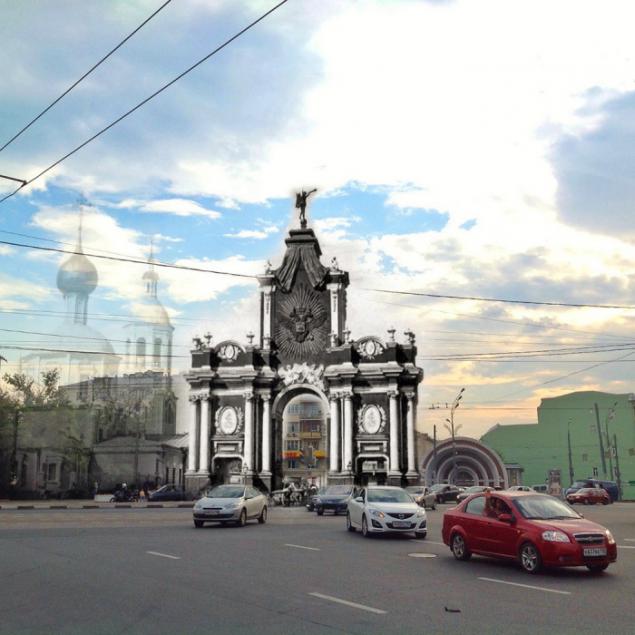
Red Gate.
For Muscovites first name metro station. Especially recognizable ground lobby unusual shape. The station was built in 1935 as part of the first phase of metro. But the story of the origin of the name. This gate is set in 1709 on the orders of Peter the Great in honor of the victory over the Swedes at Poltava, called them the Triumphal Gate. Then the gates were replaced with new ones in 1724, and a few years later they were burned. In 1742 they rebuilt, and they were burned again. And only in 1753 they hit upon the idea of making the stone. The walls of the gate were blood red (which is why they are red) with white relief in the Baroque style. The entire structure was crowned by a statue of an angel. Arch lasted until 1927, it prevented the expansion of the Garden Ring. At the same time the church was demolished and the Three Hierarchs adjacent.
By the way, this place is directly connected with Lermontov. He was born in the house next door - now on the site of this house is a Stalinist skyscraper. From 1962 to 1986, the area was known as Lermontov. Name of a metro station in this period, too, have changed on Lermontov. And there stands a monument to Lermontov nearby.
Find the exact position of the gate was difficult. We can say that in this picture it is about, because almost all the houses around were built in the 30s, when the gate was gone. But I was guided by the position of the streets and the corner of the building. The gates were in place internal bandwidth of the Garden Ring. From the gate was preserved sculpture of an angel, she is kept in the Historical Museum.

Vasilevsky descent.
Let's start with the fact that the mapping is no concept of "descent", so this place is called area Vasilevsky descent, although few area used to call this place. As seen on the pictures, there stood before the house. Here at the Customs office where the fees are payable to gather in Moscow cattle. Later there appeared many trading shops. In 1937 the house was demolished and then built a new bridge Moskvoretsky.
If you look at the history of the Moscow metro, the originally planned here pave the subway. But not under the earth, and over, almost like a monorail now in the north of Moscow. The idea of a grand, perhaps for its implementation and all the houses were demolished. In Red Square planned station of the same name "Red Square". But the plans were changed with the construction of the subway many times, and the project was abandoned.
A little bit about the history of the name. Vasilievskaya area called the space between the St. Basil's Cathedral, built in 1561, and the Kremlin, but then this area was connected to the Red Square. A name Vasilevsky descent given only in 1995.
This place is also famous for the fact that in 1987 it landed here avialyubiteley German Mathias Rust, raising doubts about the firmness of Defense. After this event, the Muscovites often joked, giving the Red Square and Vasilievsky Slope name "Sheremetyevo-3».

Skyscraper on Tinkers waterfront.
Coast waterfront skyscraper located on the estuary Jauza. It is situated about 700 apartments, shops, a post office and a cinema "Illusion". It consists of three buildings - A, B and C. I noticed this skyscraper in the project because it was originally built only body A. This is the nine-part of a building that overlooks the Moskva River. It was built in 1938-1940 years, even before the war. Only after the war it was decided to build a high-rise across Moscow. It was built on the pre-revolutionary technologies - mixed floors, curtain walls made of boards. At first glance it seems that the second wing skyscraper (Building B, facing Yauza) built symmetrically body A. But it is not.
©
To immerse yourself in a different era, you need to find exactly the position for the picture that the photographer chose a few decades ago. All pictures are taken on the iPad and combined with old it is, right on the shooting location. That, in the opinion of the author, allows you to forget about the special image processing on the computer and brings regular users of the same cognitive Instagram to like entertainment.

Back in 1931. Demolition of the Cathedral of Christ the Savior / Our days.

KGB building - perhaps the worst building in Moscow (where a lot of people were shot, and there was almost a century sit power structures of our country).
First building was built in the neoclassical style to the insurance company "Russia", but it gave the NKVD in 1919. Then, when it was necessary to increase the inner prison for political prisoners, the building expanded, attach to it a new building in the style of constructivism. The building became asymmetric and stood there for almost half a century. And then the original facade built up, making a symmetrical building in the 80s. If you open the map Google, you'll see that the top of the building is not symmetrical, and is located in a place where to be Malaya Lubyanka.
Standing in front of the monument to Dzerzhinsky. Now it is not, but the place is in the center of the Lubyanka Square to the monument remains and looks weird. And no one knows how you can put a monument there, because the poet put in front of "bloody" building unethical. A Soviet leaders monuments no longer set, but rumors of a monument to Gagarin.

Manezh Square and Ryad.
Ryad is so called because in the past there has sales ranks of suburban hunters who sell meat and poultry. Of all the things in frames, save only the building of the State Duma, "Moscow" hotel was rebuilt recently. On the site of the modern underground shopping center used to be a driveway. The photo shows one of the first Soviet trolleybuses YATB-1.

Big Stone Bridge.
This bridge was rebuilt twice, and now it is just downstream of the Moscow River than originally. First was built really beautiful stone bridge, which consisted of a set of arcs (in 1687). Photos of the time no, because the photo has not yet been invented, but it Vasnetsov painted the picture "All Saints stone bridge." Then the bridge was rebuilt in the one depicted in these photos - metallic, three-span (1858). And in 1938 built the existing stone bridge. Previously bridge connects the street Lenivka and was closer to the Christ the Savior Cathedral.
I am insanely inspired architecture of this bridge. Moscow lacks such beautiful designs. Modern bridges do not fit into the ensemble of the Kremlin and the historical part of the city.

Sukharev Tower (view from Sretenki).
At first I could not pick the correct position for the photos because guided by the bell tower of the temple of the Trinity in sheets, but, as it turned out, this bell tower several times changed shape. And today - is recreated from photographs. She has all the proportions are met, but the size of it came a little more than it was before, and slightly offset relative to the initial placement. And now the main!
Sukharev Tower. She told Peter to build in 1692-m, and ordered to demolish Stalin in 1934. Decided to demolish it for a reason and now a popular problem - growing traffic transport. She stood at the intersection of the Garden Ring and Sretenka street. The photograph is wonderful 1931.
Great painters and architects have sent a letter to Stalin:
"Sukharev Tower has a sample of the great perennial building art, known worldwide and everywhere equally highly valued. Despite all of the latest advances in technology, it still has not lost its huge demonstration and educational value for construction personnel. " "We ... strongly object to the destruction of highly talented works of art, is tantamount to the destruction of the paintings of Raphael. In this case, the matter is not about Slomka odious monument to the era of feudalism, and the death of the great masters of creative thought ».
But they have not convinced Stalin ... I wonder how would look Sretenka Garden Ring and now, under the current traffic if the tower preserved?

Arc de Triomphe.
Arc de Triomphe - is a cult! Country someone won or achieved something - build an arch through which pass triumphant victors. These arches are all over the world: at the Place Charles de Gaulle in Paris, the Brandenburg Gate in Berlin or Moscow on Kutuzov. But here in Moscow arch originally was not on Kutuzov, and on Tverskaya Zastava Square in Belosrusskaya.
In 1936, as well as the Sukharev Tower, Arch was demolished in the reconstruction of the area, although it promised to restore to the same place, but not restored. More precisely restored, but where it is now established, and 30 years later. We like to break, and then build again! Arch dedicated to the victory over Napoleon.
Separately want to say that I am very surprised that the railing of the bridge over the railway Belarusian direction from which I took a picture, remained unchanged.
And an amazing feeling when you find yourself in exactly the point from which people almost a century ago, made a picture on your camera, and you're standing here with the iPad and take pictures of the same pan, but in the center of the frame is no longer of grandeur for which the person has come here with the camera. It's hard to describe it, but try it for yourself!

Tower Barbarian gate.
Now people wonder why in Moscow so many places named in honor of some gates: Nikita, Prechistenskaya, Pokrovsky, Barbaric gate. The thing is that before Moscow was surrounded by several defensive walls that were erected to protect from attacks of the Tatars, across the contour of the walls had towers with multiple gates.
Barbarian gate tower was considered the most robust in the Kitai-Gorod wall and had a deep foundation against undermining. Work on its construction began in 1534 and lasted until 1934, she when to get rid of. But now, after the underpass under the square Barbaric gate, on one wall of the transition, you will see the remains of the foundations of the tower - is all that is left of it.

Ilinskoe gate.
Continue a virtual tour of the Kitai-Gorod wall. By the way, in the late 16th century it was painted in white, and it was originally a brick. The photograph Ilyinskikh tower gate. The tower looks like the Kremlin, so it was rebuilt after a fire in 1812. This kind of Maroseika on Ilyinke. On the right hand is the building of the Museum, on the left Il'inskii Square with the monument to heroes of Plevna. Ilinskoe gates were located between Nikolskie and barbaric gate. Ilinskoe gate originally built in 1534, along with the Kitai-Gorod wall. Destroyed it all in 1933.
After the demolition of the gate named after them Ilinskoe gate area. Also wanted to call and a subway station, but the station decided not to build. Have you noticed that between the Revolution Square and Kursk too far? That's just on this site should be Ilinskoe station gates.

Vladimirskie gate.
Travel Kitaygorodskaya wall continues. Where now is Lubyanka Square, before the gates were Vladimirskie (they Sretensky or Nikolsky). Make this picture was harder earlier - there are no landmarks, cling to determine where is the tower and the gate and where the pictures were taken preserved. First, at this point in the time of Stalin tore down the wall, the temples of the walls, towers and gates, and built the first phase of the metro station - Dzerzhinsky (now Lubyanka) in 1934. And then when Luzhkov in 1998 built the shopping center "Nautilus", which is quite out of place in this part of town. Because of this huge shopping center is not visible houses on St. Nicholas.
I studied long-lasting prints and found a picture, which shows the tip of the Tretyakov Gate and glass dome of the hotel "Metropol". With these two reference points and their intersection at the pictures I already had a line, which was a picture was taken, but still lacked some clues. She was the tip of the apartment building on St. Nicholas, 21, and the angle of inclination of the Nicholas Street. Of course, there is some uncertainty, but more accurately recreate unlikely to succeed. I sketched on a map, determine the point of shooting, and went to shoot. The result is that the gate is in what is now the roadway (turn directions to the Theatre of New Square). At the place where now the Lubyanka station lobby, used to be a temple of the Vladimir Mother of God, and on-site shopping center "Nautilus" was a beautiful chapel of St. Panteleimon the Healer (pictured). Overall Lubyanka Square earlier was not as big as it is now.
Tower, as well as in Ilyinskikh gate, similar to the Kremlin as it was rebuilt in this style after a fire in 1812. Vladimirskie gates were second-hand city center. Most bookshops are found here. They settled in St. Nicholas deadlock. He was named so because it rested in Kitai-Gorod wall, but then in the wall made a small gate so that people could travel with the theatrical run to the bookstore. Almost all the houses here were destroyed in 1934. So Nicholas deadlock now is an imaginary place.

Resurrection (Iberian) gates and zero kilometer.
Built - broke - again built, if it is brief. Usually nobody thinks, but Resurrection Gates are Kitaygorodskaya wall. They are among the Historical Museum and the City Duma building and are the entrance to Red Square.
Gate built in 1680, destroyed in 1931 by order of Stalin, because road transport had to go to the Red Square, and military equipment are not held in such a narrow gate. For a long time there was a roadway, which is named after the Historical Museum - Historical travel, just to photograph it. Restore them in 1994. Luzhkov! And then did the pedestrian zone.
Before the gate is zero kilometer. It was established not long ago - in 1995. Here tourists throw coins over your left shoulder. But in fact it is not a zero kilometer. This is located at kilometer zero of the Central Telegraph building. Just in the Soviet time it wanted to establish before the mausoleum, but did not, and the bronze sign made and installed it in the nineties have recovered Resurrection Gate just. In Paris, for example, zero kilometer is at Notre-Dame de Paris.

House under the skirt.
This unusual name for this house, built in 1940, has appeared in the nation. The thing is that on the roof of the house at the intersection of Tverskaya Street (formerly Gorky) and the Boulevard was a sculpture of a ballerina. Until our days the sculpture is not preserved. There are several legends, why it was dismantled:
she began to break down and can not withstand wind flows, it was dismantled in order to not fall on passersby;
in time of war it wanted to remove in order to hide the prominent landmarks and enemy aircraft that was difficult to navigate the city, although the war she went through and stood up to the year 1958-1963 (the exact date of dismantling was not found);
Minister of Culture EA Furtsevoy not like the fact that she was in too short skirt and located on a hill.
There is a legend that the ballerina Lepeshinskii, the image of which was made sculpture, broke her arm and hand sculpture immediately fell off. After that, and made a complete dismantling, fearing the fall of other parts of the body at passersby.
Large pictures of this sculpture is not found, although it stood almost 20 years and was very noticeable. I think the sculpture of a ballerina on the roof is much better than the glowing logos, filling the entire roof of Moscow.
By the way, the site of this house until 1933 stood Demetrios Church.

Metro station Comintern Street
Before the Russian State Library (Lenin Library) was the Comintern Street station lobby. Now the station is called "Alexander Garden" and that it has no lobby. There are only a general lobby station Arbat, located right in the building of the Russian library. Separate lobby was dismantled in the 40s. Now this place is an underground passage from which you can go on the subway, and a monument to Dostoevsky, established in 1997.
Comintern Street subway station was part of the first Moscow metro. Through its lobby could go down to the station and the Lenin Library, but the transplant between two stations was not originally.
The station also was called "Kalinin" (1946 and 1990). A few days in 1990, it was called "Vozdvizhenka" and this name even managed to put on metro.

Red Gate.
For Muscovites first name metro station. Especially recognizable ground lobby unusual shape. The station was built in 1935 as part of the first phase of metro. But the story of the origin of the name. This gate is set in 1709 on the orders of Peter the Great in honor of the victory over the Swedes at Poltava, called them the Triumphal Gate. Then the gates were replaced with new ones in 1724, and a few years later they were burned. In 1742 they rebuilt, and they were burned again. And only in 1753 they hit upon the idea of making the stone. The walls of the gate were blood red (which is why they are red) with white relief in the Baroque style. The entire structure was crowned by a statue of an angel. Arch lasted until 1927, it prevented the expansion of the Garden Ring. At the same time the church was demolished and the Three Hierarchs adjacent.
By the way, this place is directly connected with Lermontov. He was born in the house next door - now on the site of this house is a Stalinist skyscraper. From 1962 to 1986, the area was known as Lermontov. Name of a metro station in this period, too, have changed on Lermontov. And there stands a monument to Lermontov nearby.
Find the exact position of the gate was difficult. We can say that in this picture it is about, because almost all the houses around were built in the 30s, when the gate was gone. But I was guided by the position of the streets and the corner of the building. The gates were in place internal bandwidth of the Garden Ring. From the gate was preserved sculpture of an angel, she is kept in the Historical Museum.

Vasilevsky descent.
Let's start with the fact that the mapping is no concept of "descent", so this place is called area Vasilevsky descent, although few area used to call this place. As seen on the pictures, there stood before the house. Here at the Customs office where the fees are payable to gather in Moscow cattle. Later there appeared many trading shops. In 1937 the house was demolished and then built a new bridge Moskvoretsky.
If you look at the history of the Moscow metro, the originally planned here pave the subway. But not under the earth, and over, almost like a monorail now in the north of Moscow. The idea of a grand, perhaps for its implementation and all the houses were demolished. In Red Square planned station of the same name "Red Square". But the plans were changed with the construction of the subway many times, and the project was abandoned.
A little bit about the history of the name. Vasilievskaya area called the space between the St. Basil's Cathedral, built in 1561, and the Kremlin, but then this area was connected to the Red Square. A name Vasilevsky descent given only in 1995.
This place is also famous for the fact that in 1987 it landed here avialyubiteley German Mathias Rust, raising doubts about the firmness of Defense. After this event, the Muscovites often joked, giving the Red Square and Vasilievsky Slope name "Sheremetyevo-3».

Skyscraper on Tinkers waterfront.
Coast waterfront skyscraper located on the estuary Jauza. It is situated about 700 apartments, shops, a post office and a cinema "Illusion". It consists of three buildings - A, B and C. I noticed this skyscraper in the project because it was originally built only body A. This is the nine-part of a building that overlooks the Moskva River. It was built in 1938-1940 years, even before the war. Only after the war it was decided to build a high-rise across Moscow. It was built on the pre-revolutionary technologies - mixed floors, curtain walls made of boards. At first glance it seems that the second wing skyscraper (Building B, facing Yauza) built symmetrically body A. But it is not.
©

